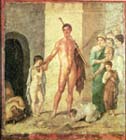

Our painting from the House of Gavius Rufus at Pompeii depicts the myth of Theseus, the slayer of the Minotaur. Theseus is an Athenian hero, the son of the king of Athens. The Minotaur, a monster that is part man and part bull, is kept in the labyrinth at Knossos, on the island of Crete, where Minos is the king. The monster's identification--Monotaur--derives from Minos (the king) and taurus (bull).
The Athenians owed allegiance to Minos and were required to send a yearly offering of youths and maidens to be sacrificed to the Minotaur. Needless to say, the Athenians did not find this arrangement satisfactory. Eventually, Theseus led the annual delegation to Knossos. He entered the labyrinth and slew the Minotaur.
The moment after the slaying of the Minotaur is depicted in our painting. The Minoatur is dead. Theseus stands in the center holding his club. The children, who thought they would not come back from lunch, express their joy and relief. And finally a group of women, a man, and a child look on from the right side of the painting.
In the image below the figures are labelled.
There is more to the story. Not told in this painting are the circumstances by which the Minotaur was created, the romance between Theseus and the king's daughter, Ariadne, and the unhappy events that follow the departure of Theseus and Ariadne from Crete.
Go back to the beginning of the exercise.
Jump to background information.
Continue with the analysis of the painting.